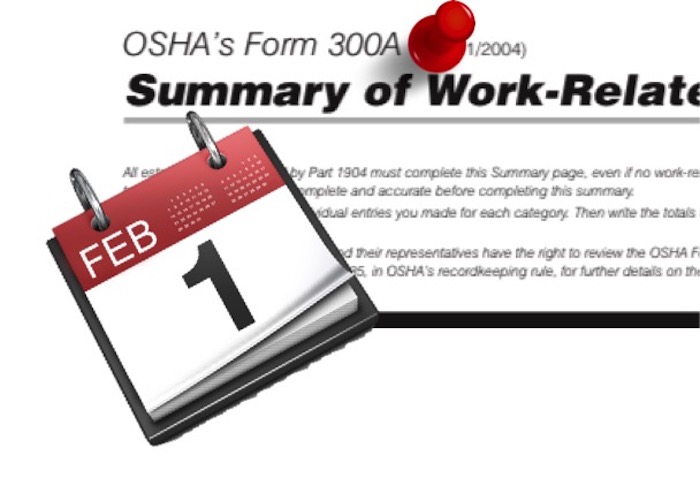Safety First News
Top 5 Employer Mistakes Regarding OSHA Form 300A

January 28, 2018
For many employers, February 1 is the annual deadline in the United States to post the OSHA Form 300A, a summary of the previous year’s injuries and illnesses recorded on the OSHA Form 300 log.
Employers with eleven or more workers at any point during the course of the previous year (except those operating in a low-hazard industry as defined by OSHA’s list of Partially Exempt Industries) must post the Form 300A summary in a “conspicuous” location, which means where notices are usually placed for workers to see (like beside the time clock or in a break area, etc.).
Top 5 mistakes employers make with the OSHA Form 300A
We often find employers making these common mistakes:
- Not posting the Form 300A at all, or posting it in the wrong place
- Not maintaining the logs on file as required
- Failing to include injuries and illnesses of temporary workers when required
- Not properly accounting for days away from work, transfer or restriction when those days extend into the following year, and
- The Form 300A was not “certified” by a proper company official.
Not posting the Form 300A Annual Summary at all, or posting it in the wrong place
Many companies mistakenly avoid keeping OSHA recordkeeping logs because of the “fewer than 10 rule,” meaning companies with fewer than 10 employees are not required to keep OSHA Forms 300 or 300A. The mistake employers make is assuming exemption from the rule if the employer has fewer than 10 employees by the end of the calendar year, which is not the case. If at any time during the year, an employer has more than 10 workers (full-time, part-time, temporary, and seasonal workers must be counted), the employer is required to maintain OSHA Forms 300 and 300A.
Another mistake some companies make is not posting the Form 300A Annual Summary when there were no injuries or illnesses in the previous year. Even if there were zero injuries and illnesses in the previous year, an OSHA Form 300A must be posted properly with zeros in the columns.
The 300A Annual Summary must be posted at each jobsite from Feb. 1 to April 30, in a conspicuous area where notices to employees are customarily placed.
Not maintaining the logs on file as required
After the OSHA Form 300A Annual Summary has been taken down from its posted position after April 30th, the form (along with accompanying OSHA Form 300 and, when necessary, 301) must be retained and maintained for 5 years.
Are digital versions of the logs acceptable means of retention?
No, digital versions of the logs are not acceptable means of retention; not in the form of a spreadsheet or database form. As an employer, you may be required to demonstrate to an OHSA Compliance Officer that the previous years’ OSHA Form 300A annual summaries were each certified, and the only way to do this is to retain the original printed and certified by handwritten signature 300A documents. A digital scan of the document is adequate, but it is recommended the original documents be kept on file.
Another mistake employers make is filing away OSHA’s recordkeeping forms for 5 years, and not continually maintaining them as needed. OSHA’s recordkeeping regulations require employers to update Form 300 Logs with newly discovered recordable injuries or illnesses, or to correct previously recorded injuries and illnesses, to reflect changes that have occurred. This requirement applies only to the 300 Logs –technically, there is no duty to update 300A Forms or OSHA 301 Incident Reports.
Failing to include injuries and illnesses of temporary workers when required
The OSHA standards require employers to record all injuries and illnesses for recordable incidents on OSHA Forms 300, 301 and 300A Annual Summary, which includes incidents suffered by any worker if you are directing their day-to-day activities. That is typically the case where a company contracts with a temporary worker service -the exception being when the temp service is also supervising the actual work being performed by their workers.
Not properly accounting for days away from work, transfer or restriction when those days extend into the following year
All “Days away from work” and number of days “On job transfer or restriction” are to be included in the year of the corresponding injuries or illnesses. For example, if a worker is injured on December 20, 2017 and returns to work on January 2, 2018 per doctor’s orders, the day not at work on January 1 is counted on the 2017 OSHA Form 300 (along with the 11 days in 2017) instead of the 2017 OSHA Form 300. Counting the number of calendar days away from work accurately is a critical component of preparing the OSHA Form 300A Annual Summary properly.
If the worker is injured on December 20, 2017 and has not returned to work by the time the OSHA Form 300A Annual Summary (for 2017) is posted (February 1, 2018), estimate the total number of calendar days you expect the worker to be away from work, use this number to calculate the total for the annual summary, and then update the initial log entry later when the day count is known or reaches the 180-day cap.
If the worker refuses to return to work by the time the licensed healthcare provider said the worker would be able to return to work, use the prescribed number of days away from work the licensed healthcare provider initially issued.
If the worker doesn’t want to take days away from work (or restriction/transfer) as prescribed by the licensed healthcare provider, the employer must still use the number of days prescribed by the healthcare provider on the Form 300 and 300A.
The Form 300A was not “certified” by a proper company official
The OSHA Form 300 Log and the OSHA Form 300A Annual Summary are required to be “certified” by a “company executive,” which means the company executive certifies they:
- Personally examined the OSHA Form 300A Annual Summary;
- Personally examined the OSHA Form 300 Log used to develop the OSHA Form 300A Annual Summary; and
- Reasonably believe, based on their knowledge of their companies’ recordkeeping processes that the OSHA Form 300A Annual Summary is factually correct and complete.
Employers typically make the mistake of allowing a non-sufficient “company executive” to certify OSHA documents. OSHA’s interpretation of company executives, as stipulated in 1904.32(b)(4), include the following individuals:
- An owner of the company (only if the company is a sole proprietorship or partnership);
- An officer of the corporation;
- The highest ranking company official working at the establishment (location); or
- The immediate supervisor of the highest-ranking company official working at the establishment.
These criteria typically do not include the safety manager, HR manager, production manager, etc.
A possible 6th mistake employers might make –confusing OSHA Form 300A posting with the Electronic Recordkeeping Rule
OSHA’s recent deadline or the upcoming deadline for electronically submitting recordkeeping information onto its online database should not be confused with posting the paper version of the OSHA Form 300A in a conspicuous location for workers to see. The previous deadline for many employers to electronically upload OSHA Form 300A information from the 2016 calendar year was December 31, 2017. The upcoming deadline to upload this information for the 2017 calendar year is currently July 1, 2018.
Keep in mind the Electronic Recordkeeping Rule may change and/or the deadline may be delayed, so hold off uploading 2017 data to OSHA’s website for the time being. OSHA appears to be working on a Notice of Proposed Rulemaking to revisit the Electronic Recordkeeping Rule and modify it or quash it completely.
If possible, hold off until early June of this year to make preparations to upload 2017 OSHA Form 300A information to OSHA’s database.





